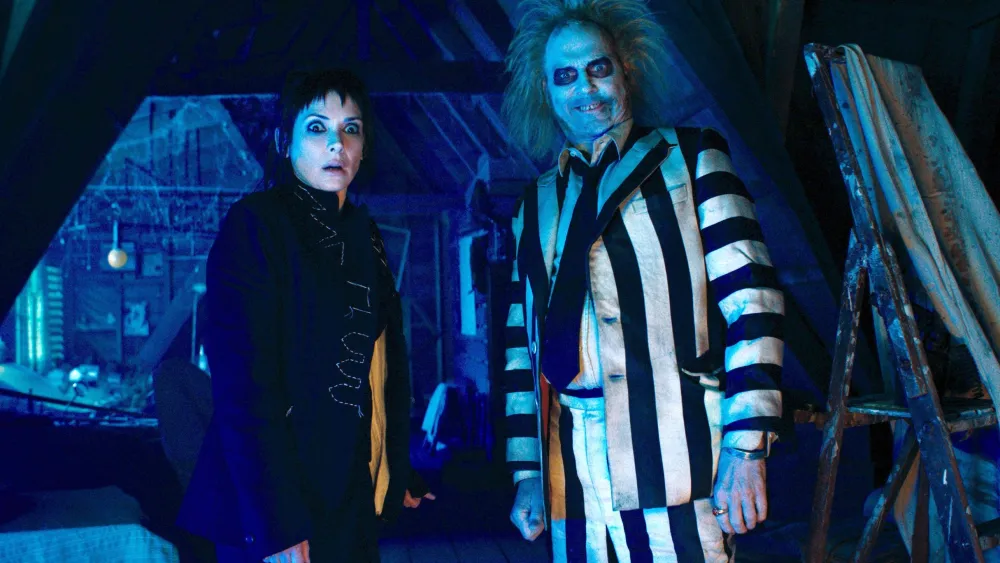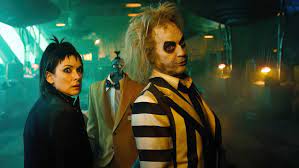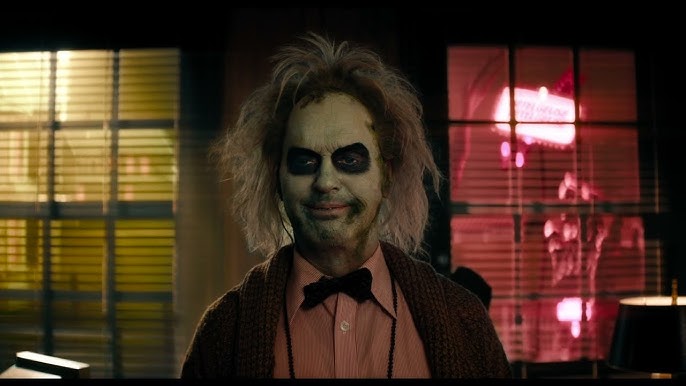🎬 Beetlejuice Beetlejuice (2024)

Beetlejuice Beetlejuice (2024) Review
Introduction
Directed by Tim Burton, Beetlejuice Beetlejuice (2024) is a highly anticipated sequel to the 1988 cult classic Beetlejuice. Returning with Michael Keaton reprising his iconic role as the mischievous bio-exorcist, the film reunites audiences with Burton’s unique gothic aesthetic and offbeat humor. Joined by Jenna Ortega, Winona Ryder, and a cast of new faces, this sequel aims to recapture the eccentric charm of the original while introducing fresh elements for a new generation.
Plot Overview
Set decades after the events of the original film, Beetlejuice Beetlejuice follows Lydia Deetz (Winona Ryder), now a protective and eccentric mother to her teenage daughter, Mia (Jenna Ortega). When Mia accidentally summons Beetlejuice (Michael Keaton) by uttering his name three times, chaos ensues as the spectral trickster re-enters their lives. This time, Beetlejuice has bigger plans, aiming to escape the Netherworld entirely and wreak havoc on the living.
As Mia and Lydia seek help from the ghostly Maitlands and other denizens of the afterlife, they uncover secrets about Beetlejuice’s origins and must navigate a series of bizarre, otherworldly adventures to prevent him from disrupting the balance between the living and the dead.
Strengths
1. Michael Keaton’s Electric Return
Keaton slips effortlessly back into the role of Beetlejuice, delivering a performance filled with manic energy, irreverent humor, and undeniable charm. His presence is the heart of the film, capturing the same chaotic spirit that made the character iconic.
2. Jenna Ortega’s Standout Performance
Ortega shines as Mia, bringing depth, wit, and a sense of youthful curiosity to the story. Her chemistry with Keaton and Ryder helps bridge the generational gap, appealing to both longtime fans and new viewers.
3. Tim Burton’s Signature Visual Style
The film’s production design is a feast for the eyes, with Burton’s trademark blend of gothic whimsy and surrealist imagery. The afterlife sequences are particularly imaginative, featuring zany set pieces and a rich palette of colors and textures.
4. Clever Humor and Nostalgic Touches
Beetlejuice Beetlejuice balances its humor between slapstick antics and sharp wit, with plenty of callbacks to the original. Fans will appreciate references to memorable moments and characters while enjoying new, inventive comedic beats.
5. Dynamic Supporting Cast
Winona Ryder’s return as Lydia adds emotional weight and continuity to the story, while the ensemble cast—including Willem Dafoe as a mysterious Netherworld bureaucrat—adds layers of intrigue and humor.
Weaknesses
1. Overstuffed Plot
The film juggles multiple subplots, including Beetlejuice’s backstory, Mia’s coming-of-age journey, and the ongoing conflict between the living and the dead. While ambitious, this results in occasional pacing issues and uneven narrative focus.
2. Heavy Reliance on Nostalgia
While the callbacks to the original are enjoyable, some moments lean too heavily on fan service, potentially alienating viewers unfamiliar with the 1988 film.
3. Underdeveloped New Characters
Despite strong performances, certain new characters, such as Willem Dafoe’s bureaucrat, feel underutilized. Their arcs lack the depth needed to make them as memorable as the returning cast.
Themes and Symbolism
1. Family and Legacy
The film explores themes of generational bonds and the impact of past decisions on the present. Lydia’s relationship with Mia mirrors her own journey from the original, highlighting the importance of understanding and acceptance.
2. Chaos vs. Order
Beetlejuice’s antics represent chaos and disruption, contrasted with the structured rules of the Netherworld. This dynamic underscores the delicate balance between the living and the dead.
3. Identity and Belonging
Mia’s journey of self-discovery parallels Beetlejuice’s quest for freedom, illustrating the universal desire to find one’s place in the world—or beyond it.
Visual and Technical Aspects
1. Cinematography
The film’s visuals, helmed by cinematographer Bruno Delbonnel, seamlessly blend live-action and CGI elements to create a dreamlike atmosphere. The use of dynamic camera angles enhances the sense of whimsy and unpredictability.
2. Production Design
From the Netherworld’s bureaucratic offices to Beetlejuice’s eccentric lair, the sets are richly detailed and brimming with Burton’s signature flair.
3. Score
Danny Elfman’s score is both nostalgic and fresh, combining iconic themes from the original with new compositions that capture the film’s playful and eerie tone.
Final Verdict
Beetlejuice Beetlejuice (2024) successfully resurrects the quirky charm of its predecessor while offering enough fresh elements to stand on its own. Anchored by Michael Keaton’s electrifying performance and Tim Burton’s visionary direction, the film is a delightful mix of humor, heart, and chaos. Despite some narrative clutter and reliance on nostalgia, it’s a worthy sequel that will please longtime fans and introduce a new generation to the world of Beetlejuice.
Rating: 8/10